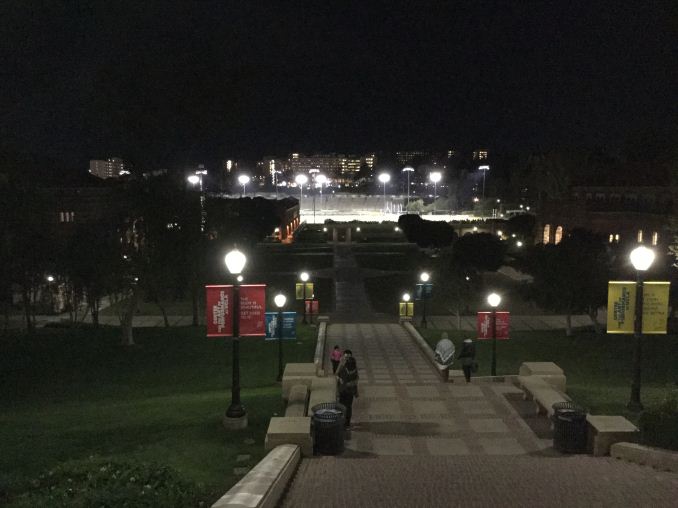The Apple iPad Air 2 Review
by Joshua Ho on November 7, 2014 9:30 AM EST- Posted in
- Tablets
- Apple
- Mobile
- iOS
- ipad Air 2
Camera
For better or worse, the camera on a tablet has become increasingly important. While there was a time when the cameras on tablets were solely used for video calls and similar functions where quality was of relatively low importance, there’s been a clear shift in the other direction. While I don’t think anyone is going to use their tablet as a primary camera, there is a level of convenience that comes with it. I’ve definitely found it to be rather intensely uncomfortable to use a tablet as a camera at all as it’s the furthest thing from inconspicuous. This brings us to the iPad Air 2, which brings the first notable camera change to the iPad line since the iPad 3, as seen below.
| Rear Facing Camera Comparison | |||||||
| Sensor | Resolution | Aperture | Focal Length | ||||
| Apple iPad Air 2 | 8 MP | 3264 x 2448 | f/2.4 | 3.3mm | |||
| Apple iPad Air | 5MP | 2592 x 1936 | f/2.4 | 3.3mm | |||
| Apple iPad 4 | 5MP | 2592 x 1936 | f/2.4 | 4.3mm | |||
| Apple iPad 3 | 5MP | 2592 x 1936 | f/2.4 | 4.3mm | |||
| Apple iPad 2 | 0.7MP | 960 x 720 | f/2.4 | 2.0mm | |||
| Apple iPad mini | 5MP | 2592 x 1936 | f/2.4 | 3.3mm | |||
While the iPad Air 2’s camera does have an eight megapixel output image, it’s important to distinguish this from the iPhone line as the sensor is noticeably smaller than what we see on something like the iPhone 6 and 6 Plus. Instead of 1.5 micron pixels, this gives us 1.1 micron pixels. In addition, the camera lacks PDAF, so focus times will definitely take a fall as a result. On the flip side, this also means no camera hump on the back.
While focus times are one thing, the difference in pixel sensitivity is likely to be the biggest difference. In casual testing, the ISO of the rear-facing camera goes between 25 and 800 ISO, and the front-facing 1.3MP camera will vary between 50 and 2000 ISO. As the tablet lacks optical stabilization, Apple has capped exposure time to a maximum of 1/15 seconds similar to what we see with the iPhone 6.
As one might guess, this difference in sensitivity doesn’t actually make for a significant difference in daytime. While 1.1 micron pixels are relatively small, daytime resolution isn’t all that far off from the iPhone 6. The extremely low sensor gain means that the impact of lower pixel sensitivity isn’t all that significant. It’s clear that the A8’s ISP does a good job of preserving detail while removing noise as we don’t see loss of detail in low contrast areas and noise in general is hard to see outside of the sky.
HDR is also quite good as one might expect, with no perceivable halos or ghosting effects from moving objects.
Unfortunately, in low light we see the weakness of the smaller pixel sizes as a significant amount of noise creeps in. This is especially obvious in preview as noise reduction doesn’t seem to be running at that point. Given the amount of noise in the preview, it’s still quite impressive how Apple manages to make the best of a system that isn’t really designed for low light photography. While a great deal of low-contrast detail is gone, there is a great deal of detail preserved and such images definitely good enough to put online if necessary. I don’t see any major color noise in the image, and luminance noise strikes a good balance between excessive blurring and obvious speckle.
In video, we see a similar pattern. On the whole, the iPad Air 2 benefits from the shared ISP from the iPhone 6’s A8 SoC as the EIS solution is surprisingly effective at suppressing high-frequency shaking. In daytime, detail in video is surprisingly good and quite close to what we see with the iPhone 6 line of devices. The one noticeable weakness is that due to the lack of PDAF, it’s necessary to stop and tap to focus on specific objects to maintain detail. There is auto-exposure, but video performance overall is a bit weaker than what one would get from the best smartphone cameras available. We see the same 17 Mbps bitrate encoded with H.264 high profile here as on the iPhone 6.
The iPad Air 2 also has a slow motion mode, which does 120 FPS at around 31 Mbps encoded with H.264 high profile and plays back at 30 FPS. The resolution is 720p, which is in line with other iOS devices for slow motion.
Once again, in low light we see the weakness in the smaller sensor. There’s a great deal of noise visible throughout the video, although there is an acceptable amount of detail and frame rate remains relatively high.
Overall, it’s hard to really find fault with the camera. While the smaller sensor size and lack of phase-detect focus does make for worse images, the camera can actually take good photos in daytime and usable photos in low light. Video follows a similar pattern as well. As said before, this camera is unlikely to be of any value as a primary camera due to the tablet formfactor. However, for applications that need a camera this should be quite serviceable.































226 Comments
View All Comments
KoolAidMan1 - Tuesday, November 11, 2014 - link
And because iOS is where the technical userbase is.Professional applications flourish on iOS. Android apps are categorically limited and low end. The ones that aren't are ports from iOS that took months or years to come over.
Also, people talking about Android usage being "technical" is hilarious. There is nothing technical about tinkering with your tablet. Next you'll be saying that messing around with your game console is "technical".
techconc - Friday, November 7, 2014 - link
That's a rather ignorant assumption. Many highly technical people prefer iOS. There are many legitimate reasons for this choice including the hardware, the software, the overall ecosystem, etc. Claiming technical people prefer Android is just as ignorant as claiming you prefer Android because you're poor. Though stereotypes do exist, these generalized claims never hold up.sonicmerlin - Friday, November 7, 2014 - link
To be fair iOS's lack of a file system makes something as simple as e-mail attachments a headache.ws3 - Saturday, November 8, 2014 - link
Of course iOS has a file system, it's just not available to the user.carloshehe - Sunday, November 9, 2014 - link
I don't know what you mean by file system and attachments.Are you having issues finding documents in your iPad?
I have Documents 5 installed. It is a complete file browser for iPad. Works like Explorer on windows. And you can add Dropbox, Google Drive, OneDrive, etc.
NEDM64 - Sunday, November 9, 2014 - link
Ftp, sftp, and with now with iOS 8 additions, is unstoppable...akdj - Monday, November 10, 2014 - link
What can't you attach to an email?Usually directly from the app you can email, post, tweet, message or FB
Hold your finger down while composing an email and you can insert what you need (native iOS mail app, but I like Mailbox for other reasons, and that's the cool thing, if the ios native app doesn't do want you want there's doxens, hundred or thousands of choices from developers ...not the case in the Play Store). It's been an option for a while and continues to get better
If you need different results look around The App Store for a third party option. They're abundant
tralalalalalala40 - Thursday, November 13, 2014 - link
Any file can be emailed. Dropbox/onedrive/box etc. you just email a link to a file. It's all very easy, takes 5 min to learn.robinthakur - Monday, November 10, 2014 - link
I'm technical, I develop in SharePoint and Drupal and support Applications and I use a Macbook Pro and an iPhone 6 Plus, as do most people in my team, so no, you are way wrong there. I also own an HTC One M8 which is fun to play around with and customise, but for a day to day phone I rely on for business, it has to be the iPhone and by extension the iPad.melgross - Friday, November 7, 2014 - link
Too bad you can't get any really good serious apps for Android.